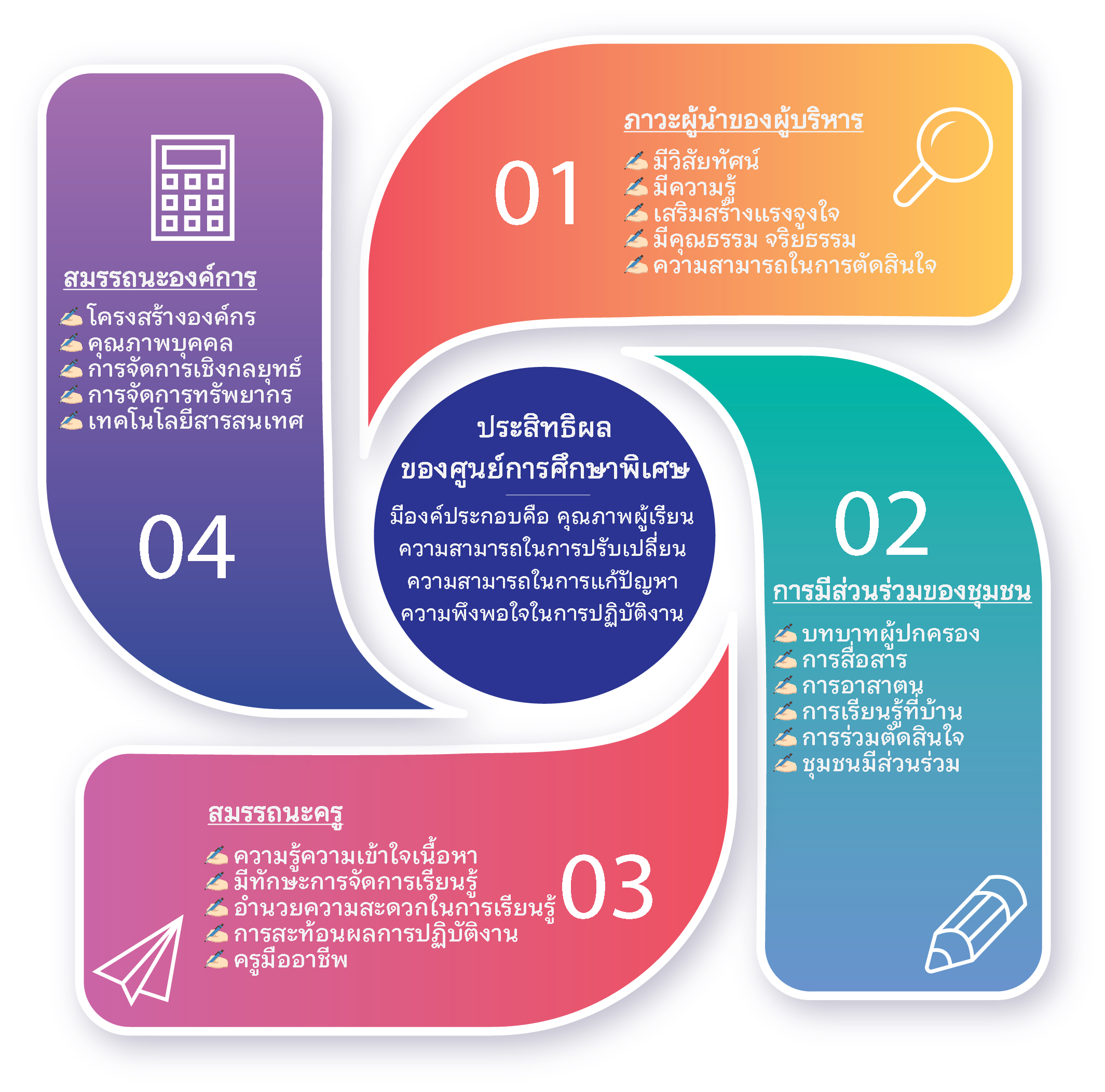The Development of Causal Relationship Model of Factors Influencing Effectiveness of Special Education Centers under the Office of Basic Education Commission
Main Article Content
Abstract
The purposes of this research were: 1) to develop a causal relationship model of factors influencing the effectiveness of special education centers under the Office of the Basic Education Commission, and 2) to verify the consistency of the causal relationship model with empirical data. The sample consisted of 500 teachers from special education centers under the Office of the Basic Education Commission, selected through multi-stage random sampling. Data were collected using a five-point Likert scale questionnaire. Statistical analyses included basic statistics such as mean, standard deviation, skewness, kurtosis, and Pearson correlation coefficients, along with confirmatory factor analysis and structural equation modeling.
The results revealed that:
1. The development of causal relationship model of factors influencing effectiveness of special education centers under the Office of the Basic Education Commission consisted of organizational competence, community participation, teacher competence, executive leadership, and effectiveness of special education centers.
2. The development of causal relationship model of factors influencing effectiveness of special education centers under the Office of the Basic Education Commission was consistent with the empirical data with Chi-Square = 66, P-value = 0.078, df = 255, GFI = 0.960, AGFI = 0.940, CFI = 0.999, SRMR = 0.999, RMSEA = 0.016, and R2 = 0.87.
Article Details

This work is licensed under a Creative Commons Attribution-NonCommercial-NoDerivatives 4.0 International License.
เพื่อให้เป็นไปตามกฎหมายลิขสิทธิ์ ผู้นิพนธ์ทุกท่านต้องลงลายมือชื่อในแบบฟอร์มใบมอบลิขสิทธิ์บทความ ให้แก่วารสารฯ พร้อมกับบทความต้นฉบับที่ได้แก้ไขครั้งสุดท้าย นอกจากนี้ ผู้นิพนธ์ทุกท่านต้องยืนยันว่าบทความ ต้นฉบับที่ส่งมาตีพิมพ์นั้น ได้ส่งมาตีพิมพ์เฉพาะในวารสาร วิชาการธรรม ทรรศน์ เพียงแห่งเดียวเท่านั้น หากมีการใช้ ภาพหรือตารางของผู้นิพนธ์อื่นที่ปรากฏในสิ่งตีพิมพ์อื่นมาแล้ว ผู้นิพนธ์ต้องขออนุญาตเจ้าของลิขสิทธิ์ก่อน พร้อมทั้ง แสดงหนังสือที่ได้รับการยินยอมต่อบรรณาธิการ ก่อนที่บทความจะได้รับการตีพิมพ์References
ชัยพร พันธุ์น้อย และวีระวัฒน์ อุทัยรัตน์. (2562). รูปแบบการบริหารการเปลี่ยนแปลงที่มีประสิทธิผลของศูนย์การศึกษาพิเศษ สังกัดสำนักบริหารงานการศึกษาพิเศษ. วารสารครุศาสตร์จุฬาลงกรณ์, 47(4), 197-207. https://digital.car.chula.ac.th/cgi/viewcontent.cgi?article=3793&context=educujournal
ธีระนัน พิรุณสุนทร. (2561). โมเดลความสัมพันธ์เชิงสาเหตุของประสิทธิผลโรงเรียนเทศบาล สังกัดองค์กรปกครองส่วนท้องถิ่น. (ดุษฎีนิพนธ์ครุศาสตรดุษฎีบัณฑิต). สกลนคร: มหาวิทยาลัยราชภัฏสกลนคร.
นิยดา เปี่ยมพืชนะ. (2559). โมเดลปัจจัยเชิงสาเหตุที่มีอิทธิพลต่อประสิทธิผลการจัดการศึกษาระดับอุดมศึกษาของสถาบันอุดมศึกษาเอกชนในภาคตะวันออกเฉียงเหนือ. วารสารราชพฤกษ์, 14(1), 25-35. https://so05.tci-thaijo.org/index.php/Ratchaphruekjournal/article/view/90974/71446
บุญชม ศรีสะอาด. (2560). การวิจัยเบื้องต้น ฉบับปรับปรุงใหม่. กรุงเทพฯ: สุวีริยาสาส์น.
เลิศชัย แก้วภักดี และดาวรุวรรณ ถวิลการ. (2565). ข้อเสนอเชิงนโยบายเพื่อเสริมสร้างความมีประสิทธิภาพการจัดการศึกษาสําหรับศูนย์การศึกษาพิเศษ เขตการศึกษา 9 จังหวัดขอนแก่น. วารสารวิชาการมหาวิทยาลัยราชภัฏภูเก็ต, 18(1), 64-78. https://so05.tci-thaijo.org/index.php/pkrujo/article/view/250782/175145
สัณหวัช อุดมเจริญศิลป์. (2564). อิทธิพลเชิงสาเหตุของปัจจัยที่มีต่อสุขภาวะเชิงอัตวิสัยและความเหนื่อยหน่ายในงานของครูศูนย์การศึกษาพิเศษ. (ดุษฎีนิพนธ์การศึกษาดุษฎีบัณฑิต). กรุงเทพฯ: มหาวิทยาลัยศรีนครินทรวิโรฒ.
สํานักบริหารงานการศึกษาพิเศษ. (2566). แผนปฏิบัติการประจำปีงบประมาณ พ.ศ. 2566. กรุงเทพฯ: สำนักงานคณะกรรมการการศึกษาขั้นพื้นฐาน.
สำนักงานคณะกรรมการการศึกษาขั้นพื้นฐาน. (2565). แผนพัฒนาการศึกษาขั้นพื้นฐาน (พ.ศ. 2566-2570). กรุงเทพฯ: กระทรวงศึกษาธิการ.
สำนักงานเลขาธิการคุรุสภา. (2562). กรอบสมรรถนะครู เอเชียตะวันออกเฉียงใต้ (ซี-ทีซีเอฟ). กรุงเทพฯ: ออนป้า.
สำนักงานเลขาธิการสภาการศึกษา. (2560). แผนการศึกษาแห่งชาติ พ.ศ. 2560-2579. กรุงเทพฯ: พริกหวานกราฟฟิค.
สำนักงานศาลรัฐธรรมนูญ. (2560). รัฐธรรมนูญแห่งราชอาณาจักรไทยพุทธศักราช 2560. (พิมพ์ครั้งที่ 3). กรุงเทพฯ: แอคทีฟพริ้นท์.
สุจินต์ สว่างศรี. (2557). การพัฒนารูปแบบการจัดการศึกษาสำหรับบุคคลที่มีความบกพร่องทางสติปัญญาในประเทศไทย. (ดุษฎีนิพนธ์ปรัชญาดุษฎีบัณฑิต). กรุงเทพฯ: มหาวิทยาลัยราชภัฏสวนดุสิต.
อุมาพร ธรรมสมบัติ. (2563). รูปแบบการพัฒนาภาวะผู้นำของผู้บริหารในโรงเรียนตำรวจตระเวนชายแดนสังกัดกองกำกับการตำรวจตระเวนชายแดนที่ 24. (ดุษฎีนิพนธ์ครุศาสตรดุษฎีบัณฑิต). สกลนคร: มหาวิทยาลัยราชภัฏสกลนคร.
Agasisti, T. (2017). Management of Higher Education Institutions and the Evaluation of their Efficiency and Performance. Tertiary Education and Management, 23(3), 187-190. https://doi.org/10.1080/13583883.2017.1336250
Derderian, A. (2014). The Effectiveness of Special Education Centers in Jordan. Journal of Scientific Research and Reports, 4(5), 410-420. https://doi.org/10.9734/JSRR/2015/13626.
Epstein, J. L. (2011). School, family and community partnerships: Preparing educators and improving schools. (2nded.). Suite: Westview Press.
Hoy, W. K., & Miskel, C. (2013). Educational administration: Theory, research, and practice. (9th ed.). New York: McGraw-Hill.
Kocak, S., & BOSTANCI, A. B. (2020). Does Public Leadership Improve School Effectiveness through Strengthening Teacher Professionalism. Eurasiam Journal of Educational Research, 90(2020), 19-44. https://www.researchgate.net/publication/349105444_Does_Public_Leadership_Improve_School_Effectiveness_through_Strengthening_Teacher_Professionalism
Rahayu, S., Ulfatin, N., Wiyono, B. B. & Kusmintardjo, K. (2017). The Effect Of Teacher's Concern To Innovation And Emotional Intelligence On The School Effectiveness Mediated By The Professional Competency Of Teachers And School Culture. International Journal of Education and Research, 5(12), 53-64. https://www.ijern.com/journal/2017/December-2017/05.pdf
Schumacker, R. E. & Lomax, R. G. (2010). A Beginner's Guide to Structural Equation Modeling. (3rd ed.). New York: Routledge.
Sheninger, E. C. (2014). Digital leadership: changing paradigms for changing times. California: Corwin.
